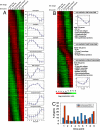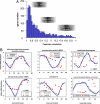The transcriptome of Plasmodium vivax reveals divergence and diversity of transcriptional regulation in malaria parasites
- PMID: 18852452
- PMCID: PMC2571024
- DOI: 10.1073/pnas.0807404105
The transcriptome of Plasmodium vivax reveals divergence and diversity of transcriptional regulation in malaria parasites
Abstract
Plasmodium vivax causes over 100 million clinical infections each year. Primarily because of the lack of a suitable culture system, our understanding of the biology of this parasite lags significantly behind that of the more deadly species P. falciparum. Here, we present the complete transcriptional profile throughout the 48-h intraerythrocytic cycle of three distinct P. vivax isolates. This approach identifies strain specific patterns of expression for subsets of genes predicted to encode proteins associated with virulence and host pathogen interactions. Comparison to P. falciparum revealed significant differences in the expression of genes involved in crucial cellular functions that underpin the biological differences between the two parasite species. These data provide insights into the biology of P. vivax and constitute an important resource for the development of therapeutic approaches.
Conflict of interest statement
The authors declare no conflict of interest.
Figures




Similar articles
-
An analysis of mobile genetic elements in three Plasmodium species and their potential impact on the nucleotide composition of the P. falciparum genome.BMC Genomics. 2006 Nov 4;7:282. doi: 10.1186/1471-2164-7-282. BMC Genomics. 2006. PMID: 17083741 Free PMC article.
-
Revealing natural antisense transcripts from Plasmodium vivax isolates: evidence of genome regulation in complicated malaria.Infect Genet Evol. 2013 Dec;20:428-43. doi: 10.1016/j.meegid.2013.09.026. Epub 2013 Oct 11. Infect Genet Evol. 2013. PMID: 24121022
-
Promoter regions of Plasmodium vivax are poorly or not recognized by Plasmodium falciparum.Malar J. 2007 Feb 21;6:20. doi: 10.1186/1475-2875-6-20. Malar J. 2007. PMID: 17313673 Free PMC article.
-
Combinatorial gene regulation in Plasmodium falciparum.Trends Genet. 2006 Feb;22(2):73-8. doi: 10.1016/j.tig.2005.12.002. Epub 2005 Dec 27. Trends Genet. 2006. PMID: 16380193 Review.
-
Genetic diversity and population history of Plasmodium falciparum and Plasmodium vivax.Parassitologia. 2006 Dec;48(4):561-6. Parassitologia. 2006. PMID: 17688177 Review. No abstract available.
Cited by
-
A suitable RNA preparation methodology for whole transcriptome shotgun sequencing harvested from Plasmodium vivax-infected patients.Sci Rep. 2021 Mar 3;11(1):5089. doi: 10.1038/s41598-021-84607-w. Sci Rep. 2021. PMID: 33658571 Free PMC article.
-
Unraveling the Plasmodium vivax sporozoite transcriptional journey from mosquito vector to human host.Sci Rep. 2018 Aug 15;8(1):12183. doi: 10.1038/s41598-018-30713-1. Sci Rep. 2018. PMID: 30111801 Free PMC article.
-
Characterization and tissue-specific expression patterns of the Plasmodium chabaudi cir multigene family.Malar J. 2011 Sep 19;10:272. doi: 10.1186/1475-2875-10-272. Malar J. 2011. PMID: 21929749 Free PMC article.
-
Genomes of cryptic chimpanzee Plasmodium species reveal key evolutionary events leading to human malaria.Nat Commun. 2016 Mar 22;7:11078. doi: 10.1038/ncomms11078. Nat Commun. 2016. PMID: 27002652 Free PMC article.
-
Advancing Research Models and Technologies to Overcome Biological Barriers to Plasmodium vivax Control.Trends Parasitol. 2018 Feb;34(2):114-126. doi: 10.1016/j.pt.2017.10.009. Epub 2017 Nov 16. Trends Parasitol. 2018. PMID: 29153587 Free PMC article. Review.
References
-
- Mendis K, Sina BJ, Marchesini P, Carter R. The neglected burden of Plasmodium vivax malaria. Am J Trop Med Hyg. 2001;64:97–106. - PubMed
-
- Krotoski WA, et al. Observations on early and late post-sporozoite tissue stages in primate malaria. IV. Pre-erythrocytic schizonts and/or hypnozoites of Chesson and North Korean strains of Plasmodium vivax in the chimpanzee. Am J Trop Med Hyg. 1986;35:263–274. - PubMed
Publication types
MeSH terms
LinkOut - more resources
Full Text Sources
Other Literature Sources
Medical
Molecular Biology Databases

